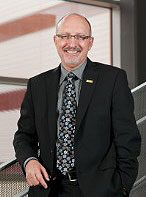Dr. Michel J. Tremblay
Host Targets of HIV
Laval University

HIV is a tricky virus; it hijacks cells of the immune system, uses their machinery, spreads to other cells and evades the immune system to persist in the host indefinitely. Development of effective treatments for HIV requires multifaceted research to study the virus and its host interactions from every angle.
Dr. Michel J. Tremblay, Canada Research Chair in Human Immuno-Retrovirology and Director of the Laboratory of Human Immuno-Retrovirology at Laval University, tackles several approaches in his study of the HIV virus. How the virus incorporates host molecules as it replicates, interactions between the virus and primary target cells (cells of the immune and nervous system), and analysis of gene profiles following viral infection are included within this busy lab’s list of projects.
Cell surface receptors (molecules on the outside of a cell) play a big role in how the HIV virus attaches and gains entry to the host cell. “The identity of novel cell surface receptors involved in the initial interactions between HIV and target cells are of high interest because it can result in design of novel antivirals,” explains Dr. Tremblay. His lab provided the first evidence that DCIR (DC immunoreceptor) acts as an HIV attachment factor, both on immune system T cells and dendritic cells.
Macrophages — host immune cells that gobble up pathogens — are important targets of HIV infection. Because they persist after becoming infected with HIV, they serve as a stable viral reservoir. But macrophages come in many forms and may not all act the same way when it comes to HIV infection. Ultimately their phenotype (polarization status) influences how the virus is consumed (through processes called endocytosis and macropinocytosis). “We reported the overall influence of the polarization process on HIV endocytosis and fate in primary human macrophages. Our results suggest that macropinocytosis is not the sole pathway involved in endocytosis of HIV in macrophages,” explains Dr. Tremblay. This could have important applications to development of antiretrovirals.
The pursuit of knowledge drives Dr. Tremblay to continue his work and he speaks highly of his graduate students “I am very proud of them because they contribute to our society in a positive manner,” says Dr. Tremblay. Always wishing to build talent in his lab, Dr. Tremblay welcomes new and enthusiastic graduate students and postdoctoral fellows.
Dr. Tremblay gives credit to his mentors for setting him on the path of HIV research; “My research interests are directly due to two mentors. I did my doctoral studies under the guidance of Dr. Mark A. Wainberg, who was one of the first Canadian scientists interested in pursuing basic research in HIV/AIDS. Thereafter, I did a postdoctoral fellowship in the laboratory of Dr. Rafick Sékaly.” He is also grateful for the support he’s received from both CIHR and CANFAR over the years “A large portion of our research efforts have been funded by CIHR and CANFAR; they have been essential to my research activities”.
The Canadian Association for HIV Research (CAHR), the CIHR HIV/AIDS Research Initiative, the Canadian Foundation for AIDS Research (CANFAR), the CIHR Canadian HIV Trials Network (CTN) and the Canadian HIV Vaccine Initiative (CHVI) Research and Development Alliance Coordinating Office (ACO), thank Dr. Tremblay and his students for their contributions to our understanding of HIV in Canada. Their work is part of a larger Canadian research effort that is making a difference in the lives of those affected by HIV in Canada and around the world.
- Date modified: